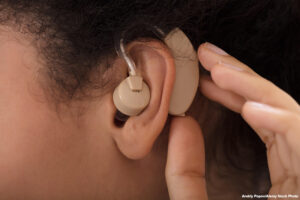
Did you know that about 60.7 million Americans ages 12 and older have some form of hearing loss? To bring attention to the achievements and challenges of people with hearing disabilities, National Deaf Awareness Month is celebrated every year in September.

Some people with hearing disabilities experience total or almost total hearing loss. They may choose to use technology like hearing aids or cochlear implants to help them hear. “Cochlear” refers to the cochlea, which is the hearing organ in the ear. They might also communicate with sign language.
Other people may experience milder forms of hearing loss. This could be the result of injury or illness, or aging. They may use hearing aids to improve their ability to hear more clearly.
Facts About Hearing Loss
Scientists and the medical community have gathered data about hearing loss.
- Hearing loss can occur at birth, or it can develop at any age.
- Noise is one of the leading causes today of hearing loss. For example, listening to music with earbuds or earphones at high volumes can cause permanent hearing loss.
- Hearing loss is on the rise in the United States.
- Studies show that about 28.8 million American adults could benefit from wearing hearing aids.
- Untreated hearing loss has a large impact on a person’s mental and emotional health. People who experience untreated hearing loss have high rates of social isolation, loneliness, depression, and anxiety.
History of National Deaf Awareness Month
To attract attention to the challenges and needs of people with hearing loss, the first International Day of the Deaf was celebrated in 1958. By 1997, the celebration had been extended to an entire month. Deaf Awareness Month is celebrated in September in the United States and Canada and in October in other countries throughout the world. During National Deaf Awareness Month, Americans celebrate individuals in the deaf community or others with hearing loss.
Celebrating Milestones
Three important events in education for the deaf are remembered for their historical significance. In 1817, the American School for the Deaf (ASD)–the United States’ first school for the deaf–opened in Hartford, Connecticut by Thomas Gallaudet and Laurent Clerc. This was an important event because many people believed at that time that people who were deaf could not be educated.
Next, Thomas Gallaudet opened the first higher learning institution for people who were deaf in 1864 in Washington, D.C. Today, it is known as Gallaudet University. It is the world’s largest university for people who are deaf and hard of hearing.
For a large part of its history, Gallaudet University was led by university presidents who were not deaf. In 1988, protests by students at Gallaudet brought about the appointment of Dr. King Jordan, the college’s first president who was deaf.
The Importance of Awareness
National Deaf Awareness Month celebrates the successes of people who are deaf and hard of hearing. It also serves as a time to further educate people about myths and misconceptions about deafness and hearing loss. For example, one common misconception is that there is a universal sign language. However, there are over 300 different sign languages used throughout the world!
In addition, Deaf Awareness Month is used to call for more inclusion in society for people who are deaf and hard of hearing. This means making sure that deaf people have access to interpreters at schools and medical appointments. The month also highlights the needs of the deaf community to local, state, and national policymakers.
